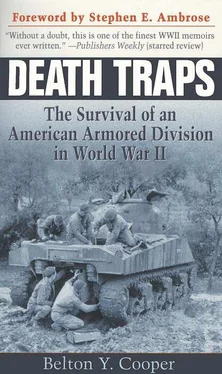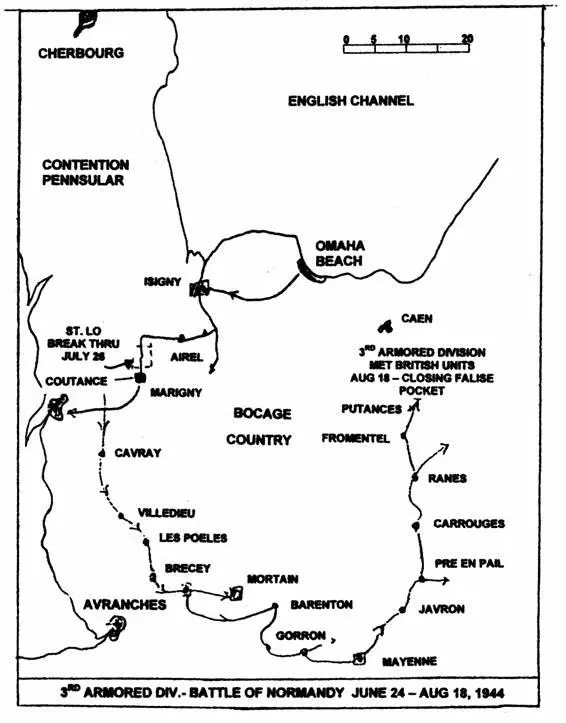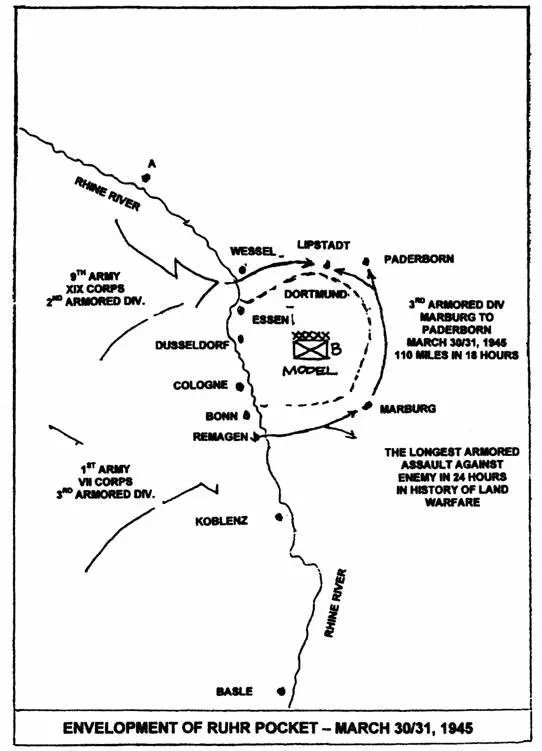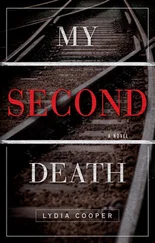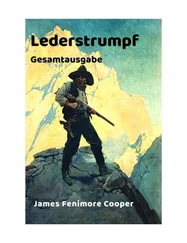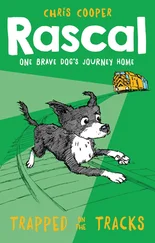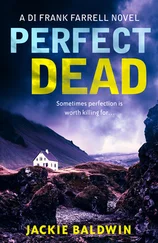It soon became obvious from reading combat loss reports on a daily basis that one could reconstruct a diary of the activities of the Combat Command. The information gathered from this material plus personal observations, conversations with other soldiers, and research in other documents (listed in the bibliography) provided a wealth of information for preparing this book. Conversations with other soldiers immediately after an operation, discounting the fact that most soldiers tend to exaggerate, provided a lot of interesting information. By combining information from many conversations from other soldiers who had diverse viewpoints with my own observations, I could obtain a fairly good picture of what was actually happening.
In conclusion, I feel that I was fortunate to be in a particular position to observe the American Army’s campaign in Western Europe during World War II because I was a survivor. I came on active duty in June 1941 at Camp Polk with a cadre group of some 400 officers. During the next three years of training in the states and in England, I got to know many of them, and became close friends with some of them. Of those assigned to positions closer to combat than I was—in the infantry, tanks, combat engineers, or as artillery forward observers—not a single one made it from the first battles in Normandy to the final battles in Germany without being killed or wounded. I had to tell this story because they could not.
With the exception of certain well known ranking officers, some names have been changed.
I would like to acknowledge several people who helped me write this book, not necessarily in the order of their importance.
While still in Germany, I confided my thoughts to my buddy, Lt. Earl Biinckley, who continually prodded me to tell my story. Dr. James Tent, professor of history, University of Alabama at Birmingham, was encouraging and introduced me to Dr. Stephen E. Ambrose. Dr. Ambrose reviewed my manuscript and used it as a reference for his book, Citizen Soldiers. As a result of this, Dr. Ambrose graciously consented to write the foreword for this book.
Dr. Russell Weigley, professor of military history, Temple University; Lt. Col. Lee Clark, Commandant of the Armored Force School, Fort Knox; John Purdy, director of the Patton Museum; Bill Hanson, director of the Armored Forces School Library; Colonel Elder, CO of the 16th Cavalry Regiment; Hanes Dugan, historian of the 3d Armored Division; Clarence Smoyer of E Company, 32d Armored Regiment.
My family: my wife Rebecca; my sons, Belton, Lloyd, and Spencer; and Lloyd’s wife, Tish, were patient, helpful, and encouraging. My secretary, Betty Hartwell, did much of the typing.
Mike Bennighof, a doctoral candidate in history, did an excellent job of editing my original manuscript. The photographs were furnished courtesy of Ernie Nibbelink, Earl Binckley, Clarence Smoyer, and Marvin Mischnick. I am indebted to Sheila Criss for producing the maps. Deborah Baxter Swaney provided considerable help with proofreading the manuscript. I am indebted to Bob Kane, Richard Kane, and E. J.
McCarthy of Presidio Press for their guidance and professionalism.
On Board the LST to Normandy
My feelings were somewhat ambivalent as I stood on the deck of the landing craft and looked down at the gently rolling seas of the English Channel. Although the water was not particularly rough, the heavily laden landing craft seemed to have a roll frequency in sync with that of my stomach. We had been advised to take seasickness pills about two hours before embarking, but because I had spent ten days crossing the entire ocean without using pills, I felt certain I would not need them to cross the narrow Channel.
Earlier in the evening, when we had loaded on the landing craft, we were immediately shown the officers’ country mess, where I proceeded to load up on buttered toast, doughnuts, and coffee. This now was my undoing, and I regretted having waited until getting out to sea before taking the pills.
In addition to being seasick, I felt thoroughly confused. My concern and apprehension about the future were somewhat offset by the excitement of participating in the largest invasion of all time. But I was also teed off.
Watching all me surrounding ships made me realize mat I should have chosen the navy; instead, I was an ordnance liaison officer in the 3d Armored Division.
During my first two years of college at the Virginia Military Institute (VMI), I took army ROTC in the artillery branch. At the beginning of my junior year, I transferred to the University of Michigan to study naval architecture and marine engineering, which had been my lifelong ambition. Because the University of Michigan did not have a naval ROTC at the time, I decided to enter the army ROTC ordnance branch, which was the closest thing to artillery offered by the university. Although I received full credit for my ROTC studies, I had to take additional hours to graduate. By fall 1941, a new naval ROTC program had been started at Michigan, but by this time I had already received my commission as a second lieutenant in the Army Ordnance Department Reserve.
The naval ROTC unit started offering ensign’s commissions for senior naval architects in the Bureau of Ships, pending graduation. I immediately submitted my transcript and took the physical exam to apply for a commission; I was accepted based on my graduation in February 1942.
But a problem surfaced during my interview with the naval commanding officer. He told me it was not possible to have simultaneous commissions in the army and the navy; I would have to resign my army commission in order to accept my navy commission. I agreed at once and requested that he contact the War Department and have me transferred to the navy. But it wasn’t that simple. According to regulations, the navy could not request that the army transfer me; 1 would have to resign. However, he would be glad to provide a letter showing that I had been offered the commission as an ensign.
Here began my enlightenment about the government’s bureaucratic machinations. One could not simply turn in a resignation. Instead, certain forms had to be requested from the War Department, filled out in triplicate, and sent back to the department. I immediately requested such forms, then waited.
In early June 1941, I received a telegram from the War Department and eagerly opened it in anticipation of good news about my requested transfer. I was shocked when I read the contents.
TO BELTON Y. COOPER SECOND LIEUTENANT ORDNANCE DEPARTMENT RESERVE stop.
CONGRATULATIONS, YOU ARE HEREBY ORDERED TO REPORT TO ACTIVE DUTY TO THE
EIGHTEENTH ARMORED ORDNANCE BATTALION THIRD ARMORED DIVISION CAMP
POLK LOUISIANA ON JUNE 22ND 1941 stop. YOU ARE TO BE RELIEVED OF ACTIVE DUTY IN
ORDER TO RETURN TO YOUR HOME IN HUNTSVILLE ALABAMA BY JUNE 22ND 1942 stop.
SINCERELY HENRY L. STIMSON SECRETARY OF WAR.
Although I did not know then that circumstances would extend my active duty and postpone my graduation until June 1946, I was upset that my plans to design the world’s first un-sinkable battleship were shot square in the rear end. It appeared incomprehensible to me that the government would insist that I remain a maintenance officer in an armored division when every year only ninety naval architects graduated as opposed to some twenty thousand mechanical engineers, who could have easily filled this position.
Читать дальше
